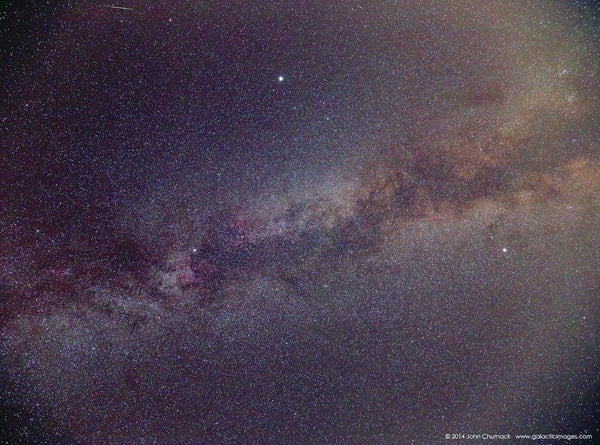Back in the January 2020 column, we toured several colorful stars in the cold winter sky. Let’s head back out this month in search of summertime gems.
We begin by aiming high in the sky toward dazzling Vega (Alpha [α] Lyrae). The brightest member of the Summer Triangle, Vega outshines its compatriots, Deneb (Alpha Cygni) and Altair (Alpha Aquilae). Vega lies 25 light-years away and is three times larger than our Sun. The striking sapphire blue color is due to a surface temperature of around 17,000 degrees Fahrenheit (9,400 degrees Celsius), about 7,000 F hotter than our Sun. That translates to a spectral class A rating.
Our next colorful stop is too faint to see by eye, but is visible through binoculars if you know where to aim them. T Lyrae is one of summer’s premiere carbon stars, sitting on the outskirts of the constellation Lyra. Carbon stars are categorized as spectral class C and are famous for their ruby red color. But T Lyrae is on the faint side for most binoculars — it shines around 8th magnitude, although it can vary. I can usually see it with my 10×50 binoculars from my suburban backyard but, to be successful, you need to know exactly where to look. Fortunately, it lies just 2° southwest of Vega. Aim your binoculars toward Vega and then shift the star toward the northeast side of the view. Without moving your aim, slide your eyes across the field. You’ll find T Lyrae against a background of faint, white stars.
From Lyra, swing one constellation east to Cygnus. There, marking the Swan’s beak, we find one of the sky’s most colorful double stars: Albireo (Beta [β] Cygni). Albireo is made up of a 3rd-magnitude spectral class K yellow star paired with a 5th-magnitude class B blue companion. They appear separated by 35″, which is tight at 10x and lower power. To split them, brace your binoculars either by mounting them on a tripod or by leaning against a fence, a parked car, or another stable surface. Higher magnification will cleave the pair apart more readily, but even at 10x, the color contrast is apparent.
Incidentally, I referred to Albireo as a double star, not a binary star. There is a difference. Binary stars are gravitationally linked to each other, while double stars are just chance line-of-sight alignments of widely separate stars. The jury is still out on whether Albireo is a true binary or an optical double. If the former, their orbital period probably exceeds 75,000 years.
As you star-surf through Cygnus with your binoculars, you will encounter many more colorful gems. One pair that always attracts my attention at this time of year is the team of 4th-magnitude Omicron1 (ο1) and 5th-magnitude 30 Cygni. You’ll find them 5° — about a binocular field — northwest of Deneb. They appear separated by 5.6′ and may be resolvable by eye alone under very dark skies. But it will take binoculars to show their true colors. Omicron1, a spectral class K star, has a light topaz tint, while 30, a spectral class A star, appears pearly white. Adding to this is a third star, HD 192579, 1.8′ south of Omicron1. This class B star appears distinctly blue, creating a very colorful triple treat.
Expanding the view, golden Omicron2 (ο2) Cygni is in the same field, 1° north-northeast of Omicron1. Omicron2 is the doppelganger of Omicron1, save for the former shining about 0.3 magnitude fainter.
Finally, 3/4° east-northeast of Omicron2 is another carbon star, the long-period variable U Cygni. When near maximum brightness, U Cygni’s cherry red glow reaches 6th magnitude, while at minimum, it bottoms out at magnitude 12. Its last maximum occurred in May 2020, which means it is currently gaining brightness, with an expected peak sometime in August. Keep an eye out for it this summer. When visible, U Cygni forms an attractive double star with an 8th-magnitude costar 2′ southeast.
This short list of summertime gems is just the tip of the iceberg. We will return to find more next summer. If you have a favorite colorful star, no matter the season, tell me about it. Contact me through my website, philharrington.net.
Until next month, remember that two eyes are better than one.










